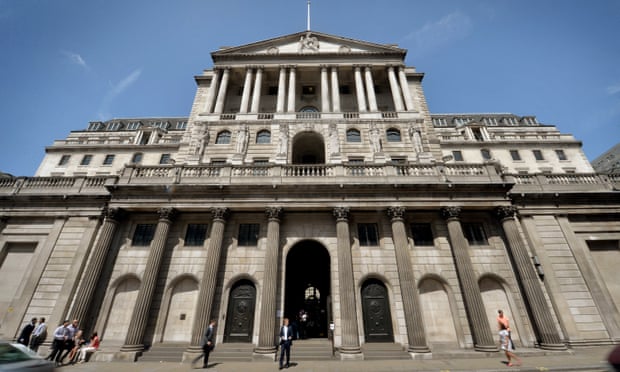Interest rates in the UK may have to be cut further from their record low level, the Bank of England’s chief economist has warned, as he highlighted signs that the global financial crisis is entering a third phase of turmoil.
Andy Haldane cited evidence of a slowdown on the domestic front and risks to the global economy from China, where an economic downturn has coincided with a stock market rout that has sent shockwaves through the world’s markets.
His view that the Bank may need to resort to even more unconventional moves to protect the UK recovery puts Haldane at odds with the Bank’s governor, Mark Carney, who has indicated that rates may rise from 0.5% early next year.
The suggestion that rates should stay low for longer will be welcomed by homeowners with tracker mortgages but is a blow to savers who have been hoping to finally see higher returns on their money. The warning from a top Bank official over the UK’s fragility is also unwelcome news for George Osborne as he seeks to emphasise his stewardship of the economy following Jeremy Corbyn’s election as Labour leader.
Haldane, one of nine policymakers who set interest rates, was speaking a day after the US central bank decided to delay an interest rate hike for the world’s biggest economy. The US rate-setters blamed a more fragile global outlook in remarks that further rattled jittery financial markets. The FTSE 100 fell more than 1% in the wake of the US decision.
In a wide-ranging speech that called on central bankers to think more radically to fend off the next downturn – including the notion of abolishing cash – Haldane warned the UK was not ready for higher borrowing costs.
“In my view, the balance of risks to UK growth, and to UK inflation at the two-year horizon, is skewed squarely and significantly to the downside,” he said. “Against that backdrop, the case for raising UK rates in the current environment is, for me, some way from being made.”
Given the range of risks facing the economy, there is every chance the next rate move could be a cut instead of an increase.
“Were the downside risks I have discussed to materialise, there could be a need to loosen rather than tighten the monetary reins as a next step to support UK growth and return inflation to target,” Haldane said in a speech entitled “How low can you go?”
Haldane’s view contrasts with comments from other members of the monetary policy committee, who have been talking up the strength of the UK economy and its ability to withstand shockwaves from slowing emerging markets.
He argued that the latest developments in China and Greece should be seen as part of a pattern. “In my view, these should not been seen as independent events, as lightning bolts from the blue. Rather, they are part of a connected sequence of financial disturbances that have hit the global economic and financial system over the past decade,” he said.
“Recent events form the latest leg of what might be called a three-part crisis trilogy. Part one of that trilogy was the ‘Anglo-Saxon’ crisis of 2008-09. Part two was the ‘euro-area’ crisis of 2011-12. And we may now be entering the early stages of part three of the trilogy, the ‘emerging market’ crisis of 2015 onwards.”
Added to that, Haldane highlighted challenges in Britain. “While the UK’s recovery remains on track, there are straws in the wind to suggest slowing growth into the second half of the year,” he said. “Employment is softening, with a fall in employment in the second quarter and surveys suggesting slowing growth rates.
“Surveys of output growth, in manufacturing, construction and possibly services, have also recently weakened. All of these data were taken prior to recent emerging-market economy wobbles.”
The suggestion of cutting rates closer to zero, or even moving to negative interest rates for the first time in the Bank’s history, adds fuel to the debate over where monetary policy goes next after more than six years of record low borrowing costs.
Haldane said central banks may have to get used to interest rates being permanently low. He appeared to dismiss the idea of making quantitative easing permanent. But one option Haldane said central banks should explore was the use of state-issued digital currencies, similar to the bitcoin virtual currency. “Perhaps central bank money is ripe for its own great technological leap forward,” he added.


